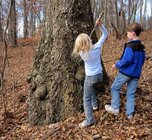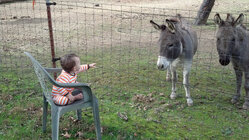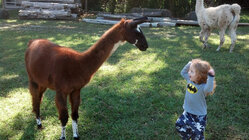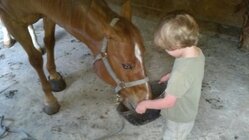(Actual roots, not the the beginnings of a woodturning obsession.)
It was suggested I post this here in addition to the Off Topic section where it was kind of hidden in the "Playing in the dirt" thread where I described digging up a big tulip poplar stump.
The biggest challenge of working with roots is getting them out of the ground!
In case anyone is interested, here are photos of a few things I've turned from roots.
Caution: roots will have a lot of dirt and sometimes rocks. I pressure wash to remove the dirt but just have to watch out for the rocks.
This one is from a Manzanita root burl. I bought some from a guy who had a bunch. Fantastic wood. The bigger ones do often have embedded rocks.

Box Elder roots can have a LOT of color, but like box elder in general the color doesn't last. I think this was from a piece of stump the late Lissi Oland gave me. It's maybe 2-3" tall.

Rhododendron roots (the bottom two pics here). Those I've turned had incredibly intricate figure I've never seen anywhere.
Hard to find big enough pieces.
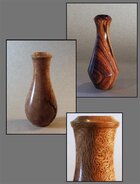
And something to keep in mind: if you find a big oak tree with a widened tapered cone-shaped "buttress" around the bottom, above and extending down into the ground, try to get that wood if the tree is downed. From two I had, the whole thing is mostly burl. I made this piece about 20 years ago. White oak.
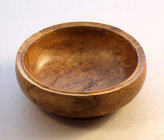
No photos, but I've had good experiences with roods and wood from a huge cherry stump and dogwood roots.
Some cherry wood I've had from below ground was amazing. It sat in the sun for weeks while I cut turning blocks from it. Compared to normal cherry wood those blocks were extra dense, figured, and simply wouldn't crack!
I once I dug up an old Dogwood stump which had been cut off level with the ground years before. I did it to help a neighbor but the wood was a surprise! Some was beautifully spalted, other pieces had more color than I've ever seen in Dogwood. All dry now, wonderful to turn. I often send wood home with visitors but no one even gets to see the what's left of that Dogwood.
Anyone turn roots or stumps?
JKJ
It was suggested I post this here in addition to the Off Topic section where it was kind of hidden in the "Playing in the dirt" thread where I described digging up a big tulip poplar stump.
The biggest challenge of working with roots is getting them out of the ground!
In case anyone is interested, here are photos of a few things I've turned from roots.
Caution: roots will have a lot of dirt and sometimes rocks. I pressure wash to remove the dirt but just have to watch out for the rocks.
This one is from a Manzanita root burl. I bought some from a guy who had a bunch. Fantastic wood. The bigger ones do often have embedded rocks.

Box Elder roots can have a LOT of color, but like box elder in general the color doesn't last. I think this was from a piece of stump the late Lissi Oland gave me. It's maybe 2-3" tall.

Rhododendron roots (the bottom two pics here). Those I've turned had incredibly intricate figure I've never seen anywhere.
Hard to find big enough pieces.

And something to keep in mind: if you find a big oak tree with a widened tapered cone-shaped "buttress" around the bottom, above and extending down into the ground, try to get that wood if the tree is downed. From two I had, the whole thing is mostly burl. I made this piece about 20 years ago. White oak.

No photos, but I've had good experiences with roods and wood from a huge cherry stump and dogwood roots.
Some cherry wood I've had from below ground was amazing. It sat in the sun for weeks while I cut turning blocks from it. Compared to normal cherry wood those blocks were extra dense, figured, and simply wouldn't crack!
I once I dug up an old Dogwood stump which had been cut off level with the ground years before. I did it to help a neighbor but the wood was a surprise! Some was beautifully spalted, other pieces had more color than I've ever seen in Dogwood. All dry now, wonderful to turn. I often send wood home with visitors but no one even gets to see the what's left of that Dogwood.
Anyone turn roots or stumps?
JKJ

